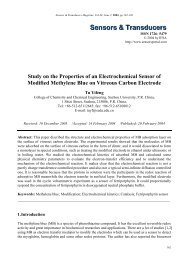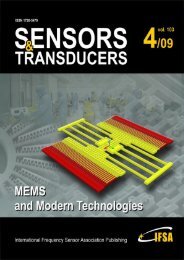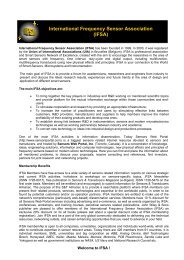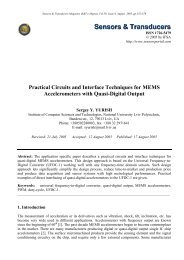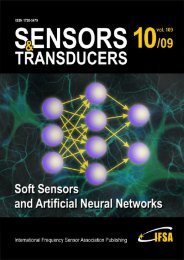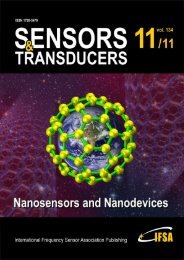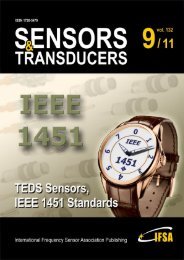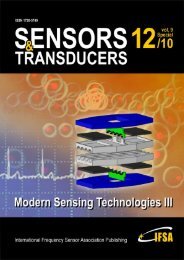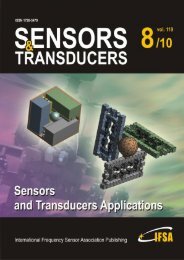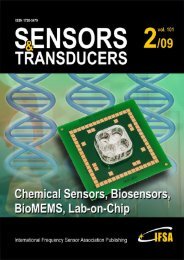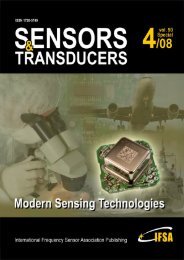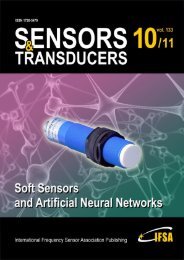Recent Advances in DNA Biosensor - International Frequency ...
Recent Advances in DNA Biosensor - International Frequency ...
Recent Advances in DNA Biosensor - International Frequency ...
Create successful ePaper yourself
Turn your PDF publications into a flip-book with our unique Google optimized e-Paper software.
3.1. Molecular Beacons (MBs)<br />
Sensors & Transducers Journal, Vol. 92, Issue 5, May 2008, pp. 122-133<br />
MBs are oligonucleotides with a stem-and-loop structure, labeled with a fluorophore at one end and a<br />
quencher on the other end of the stem that become fluorescent upon hybridization. In addition to their<br />
direct monitor<strong>in</strong>g capability, MB probes offer high sensitivity and specificity. A biot<strong>in</strong>ylated molecular<br />
beacon probe was developed to prepare a <strong>DNA</strong> biosensor us<strong>in</strong>g a bridge structure. MB was<br />
biot<strong>in</strong>ylated at quencher site of the stem and l<strong>in</strong>ked on a biot<strong>in</strong>ylated glass through strepatavid<strong>in</strong>,<br />
which acted as bridge between MB and glass matrix. The fluorescence change was measured by<br />
confirmation change of MB <strong>in</strong> the presence of complementary target <strong>DNA</strong> [34, 35].<br />
3.2. Surface Plasmon Resonance (SPR)<br />
Surface plasmon resonance (SPR) is an quantum optical-electrical phenomenon aris<strong>in</strong>g from the<br />
<strong>in</strong>teraction of light with metal surface. Under specific conditions the energy carried by photons of light<br />
is transferred to packets of electrons (photons) on a metal surface. Energy transfer occurs only at<br />
specific resonance wavelength of light [33].<br />
These biosensors are based on monitor<strong>in</strong>g changes <strong>in</strong> surface optical properties (change <strong>in</strong> resonance<br />
angle due to change <strong>in</strong> the <strong>in</strong>terfacial refractive <strong>in</strong>dex) result<strong>in</strong>g from the surface b<strong>in</strong>d<strong>in</strong>g reaction.<br />
Such devices thus comb<strong>in</strong>e the simplicity of SPR with the sensitivity of wave guid<strong>in</strong>g devices. The<br />
resonance conditions are <strong>in</strong>fluenced by the material adsorbed onto the th<strong>in</strong> metal film. A l<strong>in</strong>ear<br />
relationship is found between resonance energy and mass concentration of molecules such as prote<strong>in</strong>s,<br />
sugars and <strong>DNA</strong>. The SPR signal which is expressed <strong>in</strong> resonance units is therefore a measure of mass<br />
concentration at the sensor chip surface [36-38].It has been reported that alkane thiol modified<br />
oligonucleotide can be immobilized onto gold surface to detect <strong>DNA</strong> hybridization us<strong>in</strong>g SPR based<br />
detection <strong>in</strong> agro food <strong>in</strong>dustry [39].<br />
3.3. Quantum–Dot<br />
An ultrasensitive nanosensor based on fluorescence resonance energy transfer (FREET) can detect<br />
very low concentration of <strong>DNA</strong> and do not require separation of unhybridized <strong>DNA</strong>. Such type of<br />
technique is based on quantum-dots (QDs) which are l<strong>in</strong>ked to specific <strong>DNA</strong> probes to capture target<br />
<strong>DNA</strong>. The target <strong>DNA</strong> strand b<strong>in</strong>ds to a fluorescent-dye (fluorophore) labeled reporter strand and thus<br />
form<strong>in</strong>g FREET donor-acceptor assembly. Quantum dot also functions as to concentrate the signal by<br />
conf<strong>in</strong><strong>in</strong>g several targets at nanoscale doma<strong>in</strong>. Unbound <strong>DNA</strong> strand produce no fluorescence but on<br />
bid<strong>in</strong>g of even small amount of target <strong>DNA</strong> (≤ 50 copies) may produce very strong FREET signal.<br />
Several FREET based <strong>DNA</strong> probes (molecular beacons and TaqMan probes) whose fluorescence<br />
signals change as a result of hybridization or enzymatic reactions have been developed for separation<br />
free (unhybridized <strong>DNA</strong> strand) detection of target <strong>DNA</strong> [40-43].<br />
<strong>DNA</strong> nanosensor consists of two target specific <strong>DNA</strong> probes i.e. reporter and capture probe. The<br />
reporter probe is labeled with fluorophore whereas capture probe is labeled with biot<strong>in</strong> which b<strong>in</strong>ds<br />
with streptavid<strong>in</strong> conjugated with QD. The QD functions as target concentrator as well as FREET<br />
energy donor. When target <strong>DNA</strong> is present <strong>in</strong> solution, it becomes sandwiched by reporter and capture<br />
probes. Several sandwiched hybrids are then captured by a s<strong>in</strong>gle QD through biot<strong>in</strong>-streptavid<strong>in</strong><br />
b<strong>in</strong>d<strong>in</strong>g and concentrate at nanoscale doma<strong>in</strong> [44]. The fluorophore acceptor and QD donor close<br />
proximity caus<strong>in</strong>g fluorescence from acceptor by means of FREET on illum<strong>in</strong>ation of the donor. The<br />
detection of acceptor emission <strong>in</strong>dicates the presence of target <strong>DNA</strong>. The unhybridized probe do not<br />
participate <strong>in</strong> FREET and do not give fluorescence, therefore, it is not necessary to remove. The CdSe-<br />
125



